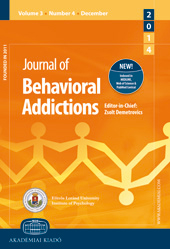Co-occurring substance-related and behavioral addiction problems: A person-centered, lay epidemiology approach
Co-occurring substance-related and behavioral addiction problems: A person-centered, lay epidemiology approach
Author(s): Barna Konkolÿ Thege, David C. Hodgins, T. Cameron WildSubject(s): Individual Psychology, Behaviorism, Crowd Psychology: Mass phenomena and political interactions, Substance abuse and addiction
Published by: Akadémiai Kiadó
Keywords: substance-related addictions; behavioral addictions; comorbidity; well-being; sociodemographic differences;
Summary/Abstract: The aims of this study were (a) to describe the prevalence of single versus multiple addiction problems in a large representative sample and (b) to identify distinct subgroups of people experiencing substance-related and behavioral addiction problems. Methods: A random sample of 6,000 respondents from Alberta, Canada, completed survey items assessing self-attributed problems experienced in the past year with four substances (alcohol, tobacco, marijuana, and cocaine) and six behaviors (gambling, eating, shopping, sex, video gaming, and work). Hierarchical cluster analyses were used to classify patterns of co-occurring addiction problems on an analytic subsample of 2,728 respondents (1,696 women and 1032 men; Mage = 45.1 years, SDage = 13.5 years) who reported problems with one or more of the addictive behaviors in the previous year. Results: In the total sample, 49.2% of the respondents reported zero, 29.8% reported one, 13.1% reported two, and 7.9% reported three or more addiction problems in the previous year. Cluster-analytic results suggested a 7-group solution. Members of most clusters were characterized by multiple addiction problems; the average number of past year addictive behaviors in cluster members ranged between 1 (Cluster II: excessive eating only) and 2.5 (Cluster VII: excessive video game playing with the frequent co-occurrence of smoking, excessive eating and work). Discussion and conclusions: Our findings replicate previous results indicating that about half of the adult population struggles with at least one excessive behavior in a given year; however, our analyses revealed a higher number of co-occurring addiction clusters than typically found in previous studies.
Journal: Journal of Behavioral Addictions
- Issue Year: 5/2016
- Issue No: 4
- Page Range: 614-622
- Page Count: 9
- Language: English

